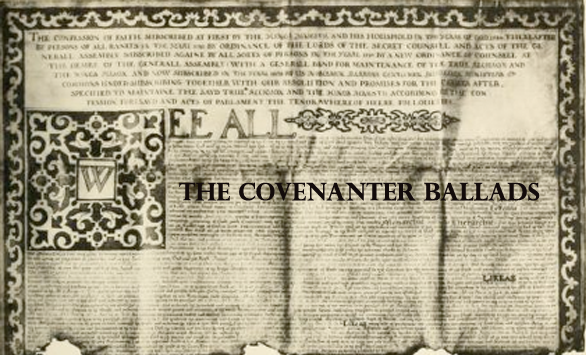Covenanter Ballads
Overview
If the Reiver ballads contain exploits of a type which were very specific to the Borders in the 16th century, then the Covenanting ballads reflect some of the struggles of the 17th century and must be viewed in a wider context, as the Covenanting struggles within Scotland are directly related to the political machinations of the English Civil War and also to religious unrest in Europe.
The Covenanting ballads are political in their aim, much more than being a form of entertainment. We have tried to remain impartial and have chosen ballads which promote both the Covenanting side and the Royalist / Governmental sides.
The earliest Covenanter revolts were due to Charles I refusal to acknowledge the National Covenant, revitalised due to the Scottish Presbyterians concern that the uniformity being brought into the English and Scottish church was overtly Anglican – a move which, in the eyes of many Scottish Presbyterians, could lead the way for Catholicism returning to dominance: the Scottish Covenenting force supported and was supported by the English Parliamentarians. The fighting force was more akin to a regular army at first, with nobles bringing their own standing armies along to join the regular Scottish forces, as well as those fighting purely for a religious cause.
After the execution of Charles I, the Scots recognised Charles II as king, but this was in direct opposition of Cromwell and the new laws of governance put in place by the English parliament, and so the Anglo-Scottish alliance was in tatters and Cromwell marched on Scotland.
After Cromwell's death and the Restoration of Charles II, battles against the government troops of Charles II rose from the king’s renunciation and destruction of copies of the Covenant, and his imposition of the divine right of the monarch. These Covenanting forces were very different from the armies of the 1630s and 1640s: these were almost entirely Covenanters, many of whom were battle hardened after the struggles against Cromwell. These skirmishes, ambushes and and battles were fought by, arguably, the most fanatical of the Covenanters. This was the era of “The Killing Times”.
Find out more about The Killing Times.
The Characters
The characters mentioned within the ballads represent some of the major political figures of the 17th Century. Many are nobles and experienced soldiers. While their names may not be familiar these days, many were highly regarded – or feared – in the 1600s. Brief biographies are provided in the text of the relevant ballads.
Covenanters
- Sir Alexander Leslie. You can also read about Sir Alexander Leslie here.
- Sir David Leslie. You can also read about Sir David Leslie here.
- Archibald Campbell, 1st Marquis of Argyll. You can also read about Archibald Campbell here.
Parliamentarian
- Oliver Cromwell. You can also read about Oliver Cromwell here.
Royalists
- King Charles I. You can also read about Charles I here.
- General Tam Dalyell. You can also read about Tam Dalyell here.
- John Graham of Claverhouse, 1st Viscount Dundee. You can also read about John Graham of Claverhouse here.
- James Scott, 1st Duke of Monmouth, 1st Duke Buccleuch. You can also read about the 1st Duke of Monmouth here.
The Marquis of Montrose
- James Graham, Marquis of Montrose is a pivotal character throughout the Covenanting years. He took up arms under the overall command of Alexander Leslie, but in 1643, he changed sides, as he considered the Covenanting forces to be playing into the hands of Archibald Campbell, 1st Marquis of Argyll, whom he considered to be making plans for his own means and advancement. The enmity between the two men was notorious. He then remained loyal to the Royalist cause, and died for it.You can read more about Montrose here.
